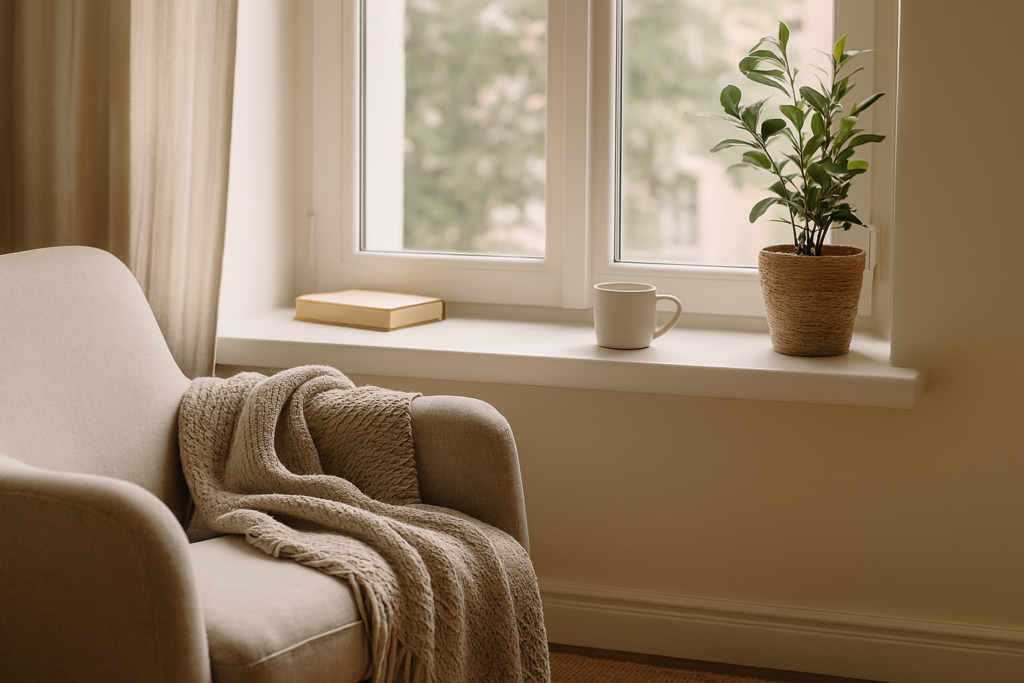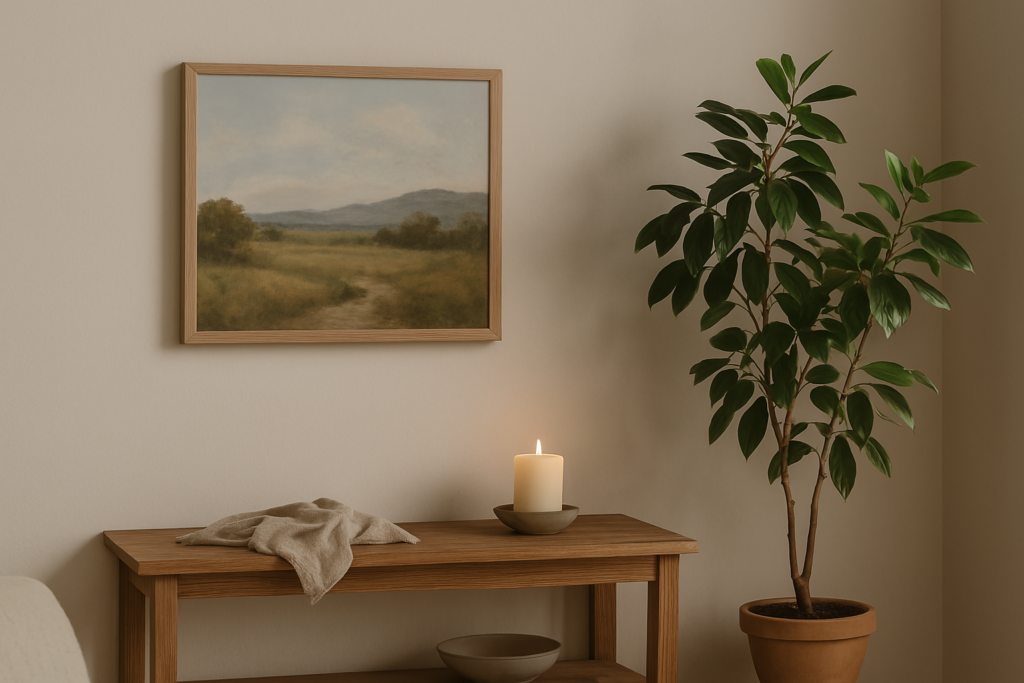Introduction: The Essence of Quietude
In the contemporary pace of life, characterized by a constant influx of activities and responsibilities, homes frequently transform into spaces filled with noise and distraction. From shared meals to collaborative work and social gatherings, these environments often revolve around interaction and stimulation. Amidst this dynamic backdrop, there lies a burgeoning need for something profoundly essential yet often overlooked—quietude. The significance of creating a designated area within the home that fosters stillness and reflection is paramount in today’s world.
Imagine a dedicated nook that invites serenity, where one can retreat from the chaos and embrace moments of solitude. This tranquil space might be as simple as a comfortable chair positioned strategically near a gentle light source or a window that frames a picturesque view of nature. Such an arrangement allows individuals to engage in self-reflection, meditation, or simply enjoy a moment of peace. These quiet corners offer an escape from the demands of everyday life, facilitating mental rejuvenation and emotional balance.
Quietude is not merely the absence of sound; it is the profound experience of stillness that allows the mind to wander freely, fostering creativity and introspection. In a world that constantly calls for action, moments spent in contemplative solitude become vital for personal wellbeing. They provide an opportunity to recharge and connect with one’s inner self, making each breath a conscious reminder of the present moment. By consciously cultivating these serene spaces, individuals can significantly enhance their quality of life, promoting greater mindfulness and enhancing emotional resilience amidst the relentless rhythm of life.

What Makes a ‘Quiet Corner’?
A ‘quiet corner’ serves as a personal sanctuary, designed to cultivate tranquility and introspection, regardless of its physical size. The essence of these spaces lies more in the intention behind their creation and the thoughtful selection of design elements rather than mere dimensions. To establish a calming environment, certain characteristics are essential.
First, seating plays a pivotal role. A cozy chair, a plush cushion, or an inviting throw can create an intimate nook that beckons you to relax. These elements should be ergonomically supportive, allowing you to sink in and detach from the outside world. The textural experience is equally important; materials such as linen or wool provide comfort while evoking feelings of warmth and serenity. Incorporating wooden accents can add an organic touch, further enhancing the sensory experience.
The quality and type of light utilized in a quiet corner significantly impact its ambiance. Natural light filtering through a window can uplift the spirit, while soft, warm lamps promote a sense of coziness during the evening. This gentle illumination invites relaxation, making it ideal for reading or unwinding after a long day.
Additionally, the presence of calming decor can transform an ordinary space into a haven. A scenic view framed by the window, a well-placed book waiting to be explored, or even a comforting cup of tea can enhance the corner’s appeal. The flickering of a gentle candle not only adds to the charm of the area but also introduces a soothing aroma, which altogether creates a multisensory experience that encourages peaceful reflection.
In essence, a quiet corner should be tailored to foster a connection with oneself, inviting individuals to engage with their thoughts and feelings in a serene setting. Through careful consideration of various components, one can cultivate an atmosphere that embodies stillness and tranquility.
How to Create Your Quiet Corner
Creating a quiet corner in your home can serve as a refuge from the hectic world, allowing for moments of reflection and stillness. To begin this process, consider choosing a location that feels inviting and naturally draws you in. This could be a sun-drenched nook by a window or a secluded corner tucked away in a room. The best quiet corners are those that resonate with your personal preferences.
Next, focus on selecting comfortable seating. A plush chair, a small couch, or even a floor cushion can provide a cozy spot to settle down. It’s important to ensure that your seating allows you to relax fully. Surrounding yourself with calming textures can amplify the tranquility of your space; consider incorporating soft blankets, pillows, or even a plush rug underfoot. These elements not only add comfort but also contribute to a visually appealing environment.

Integrating elements of nature into your quiet corner can have a profound impact on its ambiance. Plants are particularly effective, as they not only purify the air but also instill a sense of peace. Opt for varieties that thrive indoors and require minimal maintenance, such as peace lilies or snake plants. Additionally, incorporating items that evoke a sense of serenity, like candles or gentle lighting, can help set the mood for relaxation.
Personalization is key in creating a space that feels uniquely yours. Incorporate elements that reflect your interests and preferences, such as books, art, or even meaningful objects. Make sure that every item you include contributes to the overall atmosphere of calm. By curating your quiet corner intentionally, you can transform it into a haven for relaxation and contemplation, tailored to your specific needs.

Embracing Stillness in Daily Life
In our fast-paced world, the idea of stillness can often seem elusive. However, integrating moments of pause into our daily routines is vital for maintaining a sense of balance and well-being. Embracing stillness does not necessitate lengthy breaks or extensive periods of solitude; rather, it can be woven seamlessly into the fabric of our everyday lives. One effective approach is the practice of short meditative sessions. These can be as brief as five minutes, allowing individuals to close their eyes, focus on their breath, and cultivate a sense of presence. This practice not only encourages relaxation but also enhances mental clarity, helping to navigate the complexities of daily tasks.
Another way to embrace stillness is to approach simple activities, such as enjoying a cup of tea, with intention. By taking a moment to appreciate the warmth of the cup, the aroma of the leaves, and the sensation of each sip, individuals can create a mindful ritual that fosters connection with the present moment. Such mindful engagements transform routine actions into meaningful experiences, promoting a deeper awareness of oneself and one’s environment. Moreover, even in the midst of busy schedules, taking a deep breath before entering a meeting or after completing a task can serve as a powerful reminder to pause and reset.
It is essential to frame stillness not as an absence of activity but as a space rich with potential for creativity and reflection. In our quest for productivity, we often overlook the significance of these brief interludes. By prioritizing downtime, individuals can enhance their overall well-being and ensure that they approach their responsibilities with renewed energy and focus. Each small investment in stillness contributes to a deeper understanding of oneself and fosters a sense of harmony amidst life’s demands.







